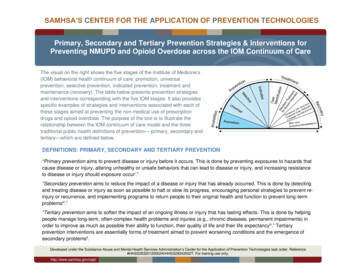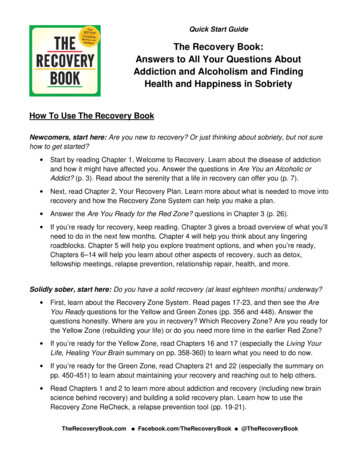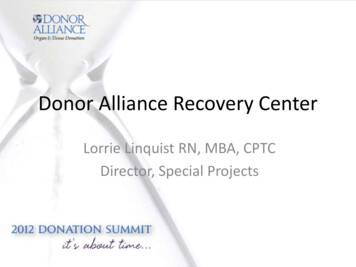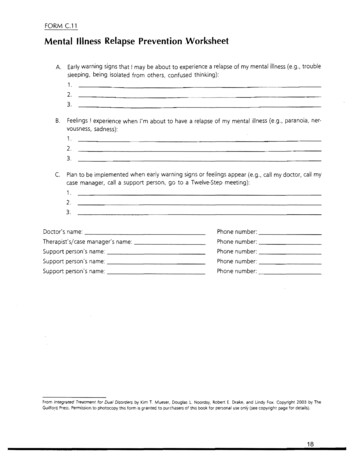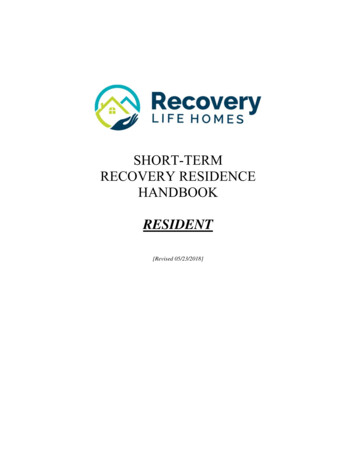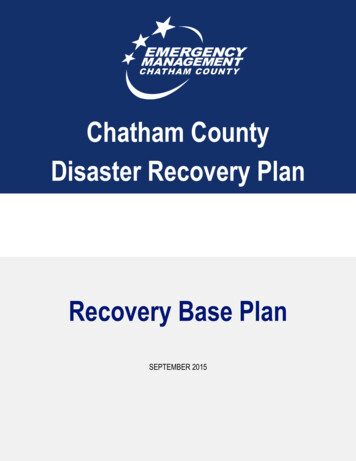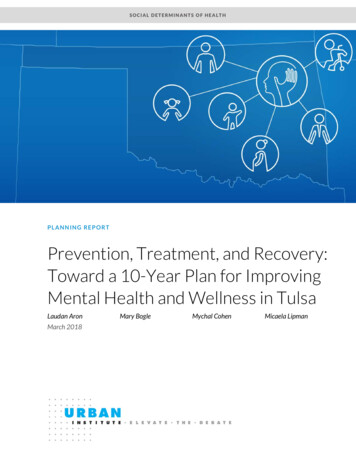
Transcription
SOCIAL DETERMINANTS OF HEALTHPLA NN ING RE P O R TPrevention, Treatment, and Recovery:Toward a 10-Year Plan for ImprovingMental Health and Wellness in TulsaLaudan AronMarch 2018Mary BogleMychal CohenMicaela Lipman
AB O U T T HE U R BA N I NS T I T U TEThe nonprofit Urban Institute is dedicated to elevating the debate on social and economic policy. For nearly fivedecades, Urban scholars have conducted research and offered evidence-based solutions that improve lives andstrengthen communities across a rapidly urbanizing world. Their objective research helps expand opportunities for all,reduce hardship among the most vulnerable, and strengthen the effectiveness of the public sector.Copyright March 2018. Urban Institute. Permission is granted for reproduction of this file, with attribution to theUrban Institute. Cover image by John Wehmann.
ContentsAcknowledgmentsvExecutive SummaryixTulsa’s Challenges and StrengthsixThe Evidence behind Tulsa’s Mental Health Plan StrategiesxiFive Action AreasxiiFour Pillars of SuccessxivMoving AheadForewordImproving Health across the Tulsa RegionA Call to ActionxvxviixviiixixIntroduction1Background3The Need for a Mental Health Continuum of Care3Addressing Mental Illness and Substance Use Disorders6Tulsa’s Challenges and Strengths9Tulsa Challenges11Tulsa Strengths14Strategies18Action Area 1. Prioritize Children and Youth20Action Area 1 StrategiesAction Area 2. Strengthen Community-Based Services/SupportsAction Area 2 StrategiesAction Area 3. Integrate Mental Health into the Health Care SystemAction Area 3 StrategiesAction Area 4. Work with Criminal Justice SettingsAction Area 4 StrategiesAction Area 5. Collaborate with Existing Community-Wide InitiativesAction Area 5 StrategiesPillar 1. Human Capital: Workforce/Education and TrainingPillar 1 Strategies2931363955575961646670
Pillar 2. Physical Capital: Facilities, Transportation, and ITPillar 2 StrategiesPillar 3. Intellectual Capital: Data, Research, Policy, and PracticePillar 3 StrategiesPillar 4. Financial Capital: Funding Sources and ModelsPillar 4 9References92About the Authors94Statement of Independence96
AcknowledgmentsThis report was developed with funding from The Anne and Henry Zarrow Foundation. We are grateful tothem and to all our funders, who make it possible for Urban to advance its mission. The views expressed arethose of the authors and should not be attributed to the Urban Institute, its trustees, or its funders. Fundersdo not determine research findings or the insights and recommendations of Urban experts. Furtherinformation on the Urban Institute’s funding principles is available at urban.org/fundingprinciples.We also thank our partners in Tulsa and Oklahoma, including those on the Tulsa Mental Health SteeringCommittee: Jeffrey Alderman, director of The University of Tulsa Institute for Health Care DeliverySciences; Melissa Baldwin, director of criminal justice reform at Mental Health Association Oklahoma;Monica Basu, senior program officer at the George Kaiser Family Foundation; Jason Beaman, assistantclinical professor and chair of the Department of Psychiatry and Behavioral Sciences at the Oklahoma StateUniversity Center for Health Sciences; Michael Brose, chief executive officer of Mental Health AssociationOklahoma; Gerard Clancy, president of The University of Tulsa; Sara Coffey, assistant professor of child andadolescent psychiatry at the Oklahoma State University Center for Health Sciences; Tom Cooper, presidentof the William K. Warren Foundation; Bryan Day, chief executive officer of 12 & 12 Inc.; Jeff Dunn, chiefexecutive officer of Mill Creek Lumber & Supply Company; Jan Figart, associate director of the FamilySafety Center; Susanna Ginsberg, president of SG Associates Consulting; Hank Harbaugh, cotrustee of theOxley Foundation; Ebony Johnson, executive director of student and family support services at Tulsa PublicSchools; Courtney Latta Knoblock, program director at The Anne and Henry Zarrow Foundation; GailLapidus, chief executive officer of Family & Children’s Services; Bill Major, executive director of the ZarrowFamily Foundations; Beatriz Pérez, program coordinator at the University of Tulsa Institute for Health CareDelivery Sciences; Mark Reynolds, director of decision support services at the Oklahoma Department ofMental Health and Substance Abuse Services; Carrie Slatton-Hodges, deputy commissioner of treatmentand recovery services at the Oklahoma Department of Mental Health and Substance Abuse Services;Richard Wansley, emeritus professor of psychiatry and behavioral sciences at Oklahoma State University;Terri White, commissioner of the Oklahoma Department of Mental Health and Substance Abuse Services;and Jay G. Wohlgemuth, chief medical officer and senior vice president of research and development atQuest Diagnostics Inc. Special thanks are due to Jeffrey Alderman, Beatriz Pérez, Mark Reynolds, andRichard Wansley for working with us on data collection and analysis.We deeply appreciate the steering committee for engaging in a true research partnership with us,exhibiting all the goodwill, hard work, and patience such an alliance requires. We are also grateful to thestaff of Mental Health Association Oklahoma and other local experts who were so generous with theirexpertise. Finally, we thank the many community members and focus group participants who graciouslyV
shared their knowledge and perspectives with us. Doris Fransein, chief judge of the Tulsa County DistrictCourt, Juvenile Division, and Michelle Robinette of the Tulsa County Sheriff’s Office were especiallygenerous with their time and insights. Sincere appreciation goes to the more than 100 consumers and familymembers who participated in focus groups or individual interviews, sharing their personal experiences andinsights into their successes and challenges with Tulsa’s mental health system and their ideas forimprovements.Other key informant interviewees are as follows: Clifton Adcock, Oklahoma WatchAnna America, Tulsa City CouncilorAlison Anthony, Tulsa Area United WayPeter Aran, Blue Cross Blue Shield ofOklahomaGlenda Armstrong, Sooner Health AccessNetworkBrooke Ashlocke, Osage NationMichael Baker, Tulsa Fire DepartmentChiefCarol Beatty, Legal Aid Services ofOklahomaJohn Bierman, Volunteers of AmericaJana Bingman, University of OklahomaDepartment of PsychiatryBrent Black, CREOKS Mental HealthServicesPhil Black, CREOKS Mental HealthServicesBryan Blankenship, Counseling &Recovery Services of OklahomaDarren Bloch, ThriveNYCJane Bowerfind, Shadow MountainBehavioral Health SystemJohn Brasher, Tulsa County DistrictAttorney’s OfficeAnn Brennan, Tulsa Housing AuthorityJohn Brennan, Tulsa County DistrictAttorney’s OfficeRich Brierre, Indian Nation Council ofGovernmentsSteve Buck, Oklahoma Department ofJuvenile AffairsFrances Burr, St. John Medical CenterG. T. Bynum, Mayor of TulsaShelley Cadamy, Workforce Tulsa VIBecky Campbell, Wagoner CommunityHospitalTessa Cheshire, Oklahoma StateUniversityJanet Cizek, Center for TherapeuticInterventionsGregg Conway, Tulsa Boys’ HomeJaclyn Cosgrove, The OklahomanCathy Costello, advocateDoug Cox, Oklahoma State House ofRepresentativesPatti Crisp, Palmer Continuum of CareInc.Matt Crum, Counseling & RecoveryServices of OklahomaCharles Danley, Grand Lake MentalHealth CenterBruce Dart, Tulsa County HealthDepartmentKim David, Oklahoma State SenateLaura Dempsey, Morton ComprehensiveHealth ServicesChris Dhoku, CREOKS Mental HealthServicesSteven Dow, CAP TulsaDoug Drummond, Tulsa County DistrictCourt JudgeF. Daniel Duffy, University of OklahomaSchool of Community MedicineJon Echols, Oklahoma State House ofRepresentativesLeon Evans, Center for Health CareServices (San Antonio, Texas)Blake Ewing, Tulsa City CouncilorJosh Firor, Center for EmploymentOpportunities
Rachele Floyd, Indian Health CareResource CenterPat Fluegel, Crossroads ClubhouseJohn Forest, St. John Medical CenterSteven Fritz, Human Skills & ResourcesRolf Gainer, Brookhaven HospitalLinda Geier, Tulsa Public Schools Studentand Family Support ServicesKaren Gilbert, Tulsa City CouncilorBrian Goetsch, Community HealthConnectionErrick Greene, Tulsa Public SchoolsDavid Grewe, Youth Services of TulsaLeslie Gross, Tulsa Housing AuthorityJennifer Hays-Grudo, Oklahoma StateUniversity Tulsa Center for FamilyResilienceCindy Hickl, University of OklahomaPACT teamCharles Hill, St. John Medical CenterEmily Hill, Morton ComprehensiveHealth ServicesMary Ann Hille, Hille FoundationGerald Hofmeister, City of TulsaMunicipal Court JudgeDonnie House, Community ServiceCouncilAlicia Irvin, Turn-Key HealthAnn Jenkins, Family & Children’s ServicesLinda Johnston, Tulsa CountyDepartment of Social ServicesDebra Jones, Parkside HospitalJustin Jones, Tulsa County JuvenileBureauMark Jones, MyHealth Access NetworkMary Ellen Jones, National Alliance onMental IllnessKaren Keith, Tulsa County Board ofCommissionersDavid Kendrick, MyHealth AccessNetworkPam Kiser, St. John Medical CenterCarol Klenda, Carol Klenda CounselingServicesSteve Kunzweiler, Tulsa County DistrictAttorney VIIJennifer Kuwitzsky, University of TulsaSchool of NursingLucky Lamons, St. John FoundationLisa Lazarus, George Kaiser FamilyFoundationMark Lepac, Oklahoma State House ofRepresentativesKrista Lewis, Family & Children’sServicesSandra Lewis, Tulsa Day Center for theHomelessShelly Lewis, Tulsa Police DepartmentSamuel Martin, Oklahoma StateUniversity Department of BehavioralMedicinePatricia Mason, Community Care ofOklahomaJim McCarthy, Community HealthConnectionColleen McCollum, Laureate Institute forBrain ResearchRebecca McRad, Sooner Health AccessNetworkAndrew Merritt, Dayspring BehavioralHealthJim Millaway, WellOK CoalitionRachel Mix, Sooner Health AccessNetworkDawn Moody, Tulsa County DistrictCourt Criminal Division JudgeBeverly Moore, Counseling & RecoveryServices of OklahomaAmanda Morris, Oklahoma StateUniversity Tulsa Center for FamilyResilienceSue Mosher, The Synergy CenterGlen Mulready, Oklahoma State Houseof RepresentativesTamara Newcomb, Muscogee (Creek)Nation Department of HealthRob Nigh, Tulsa County PublicDefender’s OfficeJeremy Nikel, Veterans AdministrationCoffee Bunker programKirsten Pace, Tulsa County District CourtJudgeAnn Paul, St. John Medical Center
Martin Paulus, Laureate Institute forBrain ResearchDavid Peters, Daybreak CounselingScott Phillips, Civic NinjasRobin Ploeger, University of Tulsa OxleyCollege of Health SciencesLeah Price, Tulsa Center for BehavioralHealthTania Price, Youth Services of TulsaCarly Putnam, Oklahoma Policy InstituteVic Regalado, Tulsa County Sheriff’sOfficeArletta Robinson, Salvation ArmyLaura Ross-White, Community ServiceCouncilDebbie Ruggels, Tulsa TransitAmy Santee, George Kaiser FamilyFoundationSusan Savage, Morton ComprehensiveHealth ServicesJim Scholl, Community HealthConnectionJohn Schumann, University of OklahomaSchool of Community MedicineSarah-Anne Schumann, CommunityHealth ConnectionGreg Shin, Mental Health AssociationOklahomaKathy Siebold, ImpactTulsaCarmelita Skeeter, Indian Health CareResource CenterRuth Slocum, Oklahoma State University,Tulsa Children’s ProjectJack Sommers, Community Care ofOklahomaGary Stanislawski, Oklahoma StateSenateChristina Starzl-Mendoza, City of TulsaMayor’s OfficeDoug Stewart, Blue Cross Blue Shield ofOklahomaZach Stoycoff, Tulsa Regional Chamberof CommerceKathleen Strunk, University of TulsaTITAN InstituteMimi Tarasch, Women in RecoveryKathy Taylor, ImpactTulsa VIIIMark Taylor, Cherokee Nation HealthServicesKeylee Tesar, YouthCare of OklahomaRoger Thompson, Oklahoma StateSenateManon Tillman, Osage NationBrian Timms, Sooner Health AccessNetworkBryan Touchet, University of OklahomaSchool of Community MedicineNicole Washington, Family & Children’sServicesRose Weller, National Alliance on MentalIllnessTammy Westcott, Community ServiceCouncilAlicia Williams, Sooner Health AccessNetworkMaggie Yar, Hille FoundationWilliam Yarborough, Oklahoma Pain andWellness Center
Executive SummaryTulsa residents living with mental illness and/or addiction die 27 years earlier than all Oklahoma residents.Their early deaths are most often caused by accidents, suicide, homicide, and overdoses. And their lives areoften marked by poor physical health, poverty, and isolation. Mental illness takes a toll not only on theseindividuals, but also on their families, their communities, and the Tulsa region as a whole.Yet residents with mental illness are not receiving the treatment they need.In response, Tulsa is embarking on a 10-year plan to improve mental health and the mental health caresystem. The plan will have four overarching goals:1.Close the gap in life expectancy between Tulsans living with mental illness and all Oklahomans.2.Lower the rates of suicide attempts and overdoses, and deaths from both causes.3.Lower the share of Tulsans who experience poor mental health.4.Reduce criminal justice system, first responder, and hospital emergency room costs caused byuntreated or poorly treated mental illness.These goals reflect the improvement of mental health and well-being for all Tulsa residents, but the planwill prioritize children and youth, as well as Tulsans with serious mental illness and addiction.This initial phase of the Tulsa Mental Health Plan initiative has been led by the University of Tulsa incollaboration with a 17-member steering committee made up of mental health care professionals,philanthropists, and community leaders. The initiative partnered with the Urban Institute to study themental health care needs and resources in Tulsa, identify gaps and inefficiencies in the health care system,and recommend ways to move forward. Our findings and recommendations draw from best practices acrossthe nation but are grounded in Tulsa’s specific needs and context.This report lays out the evidence base for Tulsa’s mental health plan by previewing the committee’semerging goals and strategies and by reviewing the data and findings on which they are based. Preliminaryrecommendations for measuring the plan’s success are also presented.Tulsa’s Challenges and StrengthsFrom September 2016 to February 2018, the Urban Institute worked with Tulsa research partners toexamine the mental health and related strengths and challenges in Tulsa and the community’s capacity toIX
improve mental health. The scope of this effort was broad, covering all residents younger than 65 across theTulsa region (Tulsa, Rogers, Wagoner, Creek, Osage, Okmulgee, and Pawnee counties).The following key findings emerged from this joint effort: Mental illness is a major driver of poor health and low life expectancy across the region. Tulsaresidents living with mental illness have a life expectancy of under 50 years. This figure rivals lowlife expectancies in some of the least developed countries in the world. In greater Tulsa, roughly140,000 residents have a mental illness and experience a wide variety of poor mental health,physical health, and social and economic outcomes. Children and youth are at increasing risk of mental illness and lack a strong foundation forlifelong mental health. According to Mental Health America, Oklahoma ranks 45th in the nation ona composite measure of youth mental illness and access to care, and 43rd on the share of youth withsevere depression who do not receive some consistent treatment. Many of Oklahoma’s youngestchildren are unwell; they experience the highest rates of adverse childhood experiences (ACEs) inthe country. Given that half of all mental illnesses appear by age 14 and three-quarters by age 24,early and effective intervention can have profound lifelong benefits. With the right supports andresources, schools and programs that serve children and youth in Tulsa can do much more toprotect the mental health and well-being of young people in their care. Tulsa’s system of care for mental health and substance use is fragmented, uncoordinated, anddominated by costly and ineffective responses. Tulsa has some pieces of a well-designed mentalhealth continuum of care, but there are many gaps, shortages, and inefficiencies. In many cases, themental health and substance use treatment system is not delivering the right care at the right timeto the right people. As a result, the criminal justice system has become the de facto setting for manyresidents with mental illness. Although Oklahoma ranks fifth in the nation on the number of mentalhealth providers per 100,000 people, many Tulsans, including families with children and people withprivate health insurance, have difficulty finding consistent and high-quality behavioral health care(i.e., care for a mental health or substance use disorder). Inadequate funding and support for mental health services constrains service provision andquality of care. Oklahoma’s current state budget crisis, past underinvestment in the behavioralhealth care safety net, and decision to forgo federal funds to expand health insurance coveragethrough Medicaid severely constrains Tulsa’s ability to address unmet mental health needs.Without major changes in state policy, Tulsa has limited ability to improve health insurancecoverage for mental health and substance use treatments and to deliver needed services.X
Many mental health problems track closely to the geography of disadvantage, reflecting areas ofconcentrated poverty, economic underinvestment, and social exclusion. Health and well-being arerooted in broader social, behavioral, and environmental conditions. Poverty, trauma,unemployment, food insecurity, and housing instability shape people’s lives, the conditions in whichmental illness and other health problems develop, and the ability to seek and get help. The rate ofmental illness among poor and near-poor residents of Tulsa (those living in households withincomes under 200 percent of the federal poverty level) is almost a third higher than that for theentire Tulsa population—19.4 percent compared with 14.2 percent. The connections betweenpoverty and mental health have important consequences for Tulsans of color. Although Tulsa hasmade strides in desegregating its neighborhoods and schools, many residents of color continue tolive in areas of concentrated poverty, with profound implications for their health and well-being.Native American and African American residents experience higher rates of mental illness than theTulsa population as a whole, reflecting long-standing inequalities in the social determinants ofhealth and mental health, and they are disproportionately represented in the publicly fundedmental health service system.Despite these challenges, Tulsa has considerable strengths, including cutting-edge treatment programsto address mental health and substance use disorders. Many existing public, private, and nonprofitcollaborations can spark and support mental health innovations in the region, and higher education andhealth care institutions are well-positioned to contribute to this effort. Tulsa civic leaders and governmentofficials are actively working to provide alternatives to incarceration for some people with serious mentalillnesses. And the state department of mental health can be a powerful partner in supporting progress inTulsa. A state opioid commission recently issued over 30 recommendations covering law enforcement, themedical community, prevention, treatment, and drug-endangered children.The Evidence behind Tulsa’s Mental Health Plan StrategiesThe Tulsa Mental Health Steering Committee used our research, as well as its own deep knowledge of localbest practices and the Oklahoma mental health policy landscape, to develop preliminary strategies for thecommunity to consider. Before finalizing the plan, the committee intends to use this report to gatheranother round of stakeholder input on its preliminary strategies.The committee’s strategies are grouped into five distinct action areas and four crosscutting pillars thatsupport all the action areas. This report includes a detailed discussion of data, some local context, and theevidence base underlying the committee’s proposed strategies. This work is summarized as follows.XI
Five Action Areas1.Prioritize children and youthAbout 19,000 children and youth in greater Tulsa—7.7 percent of the total—have a seriousemotional disturbance (a common population measure of mental illness among people younger than18). And the prevalence of mental illness among Oklahoma teens is alarming: nearly 13 percentreport experiencing a major depressive episode, according to the National Survey on Drug Use andHealth.Childhood and adolescence are critical periods for lifelong mental health. Young children are highlysusceptible to toxic stressors in their relationships and environments, and the first signs of mentalillness often appear in adolescence and young adulthood.Several stakeholders said that Tulsa has a shortage of pediatricians and mental health providerswith training in child treatment strategies. This shortfall is compounded by the lack of bilingualproviders for non-English-speaking families. Health insurance rates also drop off for youth aroundthe time they turn age 18.Schools should be one of the first lines of prevention and early intervention, but Tulsa-area schoolsare not adequately funded or staffed to address their students’ mental health needs. Efforts withinschools to promote trauma-informed approaches, social and emotional learning, and mental andbehavioral health can be powerful and effective.Based on these findings, the committee recommends developing more coordinated, systematic, andevidence-based ways for promoting mental health and well-being; preventing emerging mentalillness and substance use in children and adolescents; and managing mental health challenges ineffective and developmentally appropriate ways.2.Strengthen community-based services and supportsBeyond medical care, people living with mental illness and/or addiction can benefit greatly fromcommunity-based services and supports such as assertive community treatment, patient educationand illness self-management, family education, integrated treatment of co-occurring diseases, peerservices, supportive housing, and supported education and employment.Although Tulsa has community support programs like these, they are uneven, piecemeal, not widelyknown, and not sufficiently funded to meet the region’s needs. Strengthening these services canreduce mental health and substance use–related crises, support recovery, improve lives, and reduceXII
costs. Community-based supports can also combat the stigma and discrimination faced by manypeople and families living with mental illness or addiction.Based on these findings, the committee recommends scaling up and adding to existing communitybased services.3.Integrate mental health into the health care systemMental health and physical health are intimately linked. Many people living with mental illness oraddiction also experience physical health problems. Compared with the general population, peoplewith mental illness are more likely to have chronic illnesses, such as heart disease and type 2diabetes, and risk factors known to contribute to these illnesses, such as smoking and poor diet.Better integrating mental health and addiction treatment into the general health care system wouldhelp professionals identify symptoms of mental illness and addiction, treat patients holistically, and,when needed, refer them to specialty care. Ideally, an integrated system would screen, identify, andsupport patients and their families as early as possible; prevent or mitigate mental illness andsubstance use; avert and manage crises when they occur; and support recovery and wellness.In Tulsa, the lack of mental health integration is compounded by a shortage of public inpatientpsychiatric beds and partial hospitalization programs. Police often must drive people experiencingpsychiatric emergencies long distances across the state in search of a bed.Based on these findings, the committee envisions creating a seamless system of prevention, earlyintervention, and care that better integrates mental, addiction, and physical health care andcommunity-based supports and strengthens acute treatment options. Recent recommendationsissued by the Oklahoma Commission on Opioid Abuse will also be important in supporting thissystem of care.4.Work with criminal justice settingsOne of the major consequences of an inadequate and fragmented system of care for people withmental illness is the large number of people who, in the absence of care, fall into inappropriate,traumatizing, and costly settings such as emergency rooms, homeless shelters, and, most tragically,the criminal justice system.Of the 30,000 people who received medical care at Tulsa’s David L. Moss Criminal Justice Center in2016, a third received treatment for a mental illness. Given that the estimated annual cost ofincarcerating a person with mental illness is 23,000 and that the annual per person cost ofXIII
community-based treatment is 2,000, this failure to help people before they become involved withthe justice system is wasteful and shortsighted.Tulsa already has several well-regarded diversion initiatives that offer alternatives to incarcerationfor some people with serious mental illness or addiction problems; these initiatives often connectthem to community mental health centers. But few people with mental illness in the criminal justicesystem benefit from such programs. And residents with mental illnesses who are entering or leavingthe criminal justice system need more support. Without access to effective reentry services in thecommunity, many Tulsans with behavioral health needs will continue to cycle in and out of thejustice system.Based on these findings, the committee supports expanding diversion programs and the availabilityof mental health and addiction treatment services. It also recommends acting on guidance from theVera Institute (on jail diversion strategies) and from the Oklahoma Commission on Opioid Abuse,chaired by Oklahoma attorney general Mike Hunter. Both initiatives, now well under way in Tulsaand across the state, will benefit from improvements in the mental health system.5.Collaborate with existing community-wide initiativesUrban and the committee identified several community programs whose activities intersect withthe committee’s interests and goals. Six multiagency coalitions are essential partners in this effort.These coalitions are working on early childhood health and education, public school performance,criminal justice, homelessness, hunger, and the social determinants of health.Based on these findings, the committee seeks to bolster and accelerate partner efforts in thecommunity, recognizing their important contributions to mental illness prevention, earlyintervention, treatment, and recovery.Four Pillars of SuccessTo achieve success in these action areas, Tulsa needs to invest in four pillars of success. These pillars providethe workforce, policy, research, physical spaces, and funding necessary to reach the plan’s goals.1.Human Capital: Tulsa has more mental health providers than many communities do, but keyinformants and focus group participants described many barriers and said that providers were stilltoo few and inaccessible. And lack of access to care is not only a problem for people who areuninsured or have low incomes; even insured people with higher incomes have trouble getting thecare they need. Stakeholders also said that providers in the region need more and better training.XIV
The committee seeks to increase Tulsa’s workforce of mental health professionals and invest intheir skills through ongoing training and guidance. The committee also aims to cross-train people inother areas of work so that they can better identify and help people experiencing poor mentalhealth or mental health crises.2.Physical Capital: Many of the plan’s strategies require improvements to the physical spaces wheremental health care is delivered. The committee has identified the need to upgrade and build newinpatient psychiatric and substance use treatment facilities, and it recommends a telereferralnavigation process so that members of the community can access care when they need it.3.Intellectual Capital: The success of any mental health improvement plan requires continuouslearning about new research findings and best practices to influence better care, policy, andfunding. The committee seeks to develop the expertise and capacity for translating mental healthand addiction research into practice and to leverage data and technology to identify behavioralhealth problems and intervene before a crisis.4.Financial Capital: Oklahoma ranks 46th in the nation in spending on mental health care. Inadequatefinancing is a major factor in the community’s poor mental health outcomes and a major barrier toimproving care. The state budget crisis not only limits the addition of new services and programsbut also threatens existing ones. The state’s many uninsured adults have limited access to publicand private-sector services. And the lack of funding and low reimbursement rates, particularly inrural areas, are barriers to recruiting and retaining mental health professionals. The committeeseeks to garner new funding at many levels—Medicare; Medicaid; Insure Oklahoma; healthinsurers; federal agencies; private philanthropy; and state, county, and city government—toincrease investment in mental health care.Moving AheadTulsa has a long road ahead in meeting the mental health needs of its citizens. But by adopting a staged andsequenced approach to its 10-year plan, ensuring it aligns with the community’s foremost needs, andbuilding on existing strengths, Tulsa should be able to create a culture of real and continuous mental
Contents Acknowledgments v Executive Summary ix Tulsa's Challenges and Strengths ix The Evidence behind Tulsa's Mental Health Plan Strategies xi Five Action Areas xii Four Pillars of Success xiv Moving Ahead xv Foreword xvii Improving Health across the Tulsa Region xviii A Call to Action xix Introduction 1 Background 3 The Need for a Mental Health Continuum of Care 3

